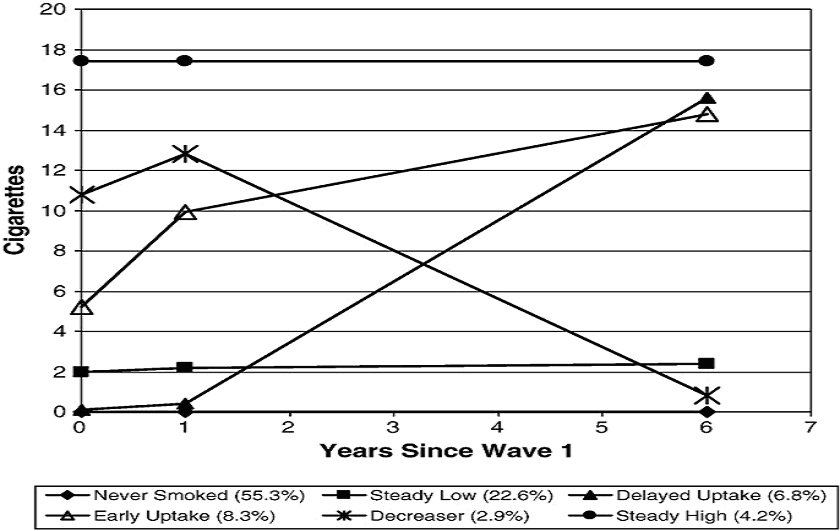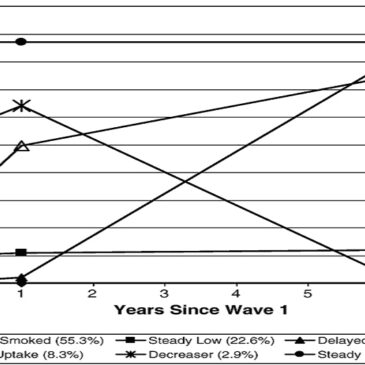A previous BASIS DRAM described a study about the relationship between friendship and addiction-related behavior, specifically, alcohol abuse. Continuing this topic, this week’s ASHES reviews a study that examined how social networks predict long-term changes in smoking behavior (Pollard, Tucker, Green, Kennedy, & Go, 2010).
Methods
- Pollard et al. used data from the National Longitudinal Study of Adolescent Health (Add Health). The research sample included students who were interviewed three times (i.e., wave I, wave II, wave III) during a six year period. The students were in grades 9 to 11 at the last wave of interviews (N = 837 for the final analysis).
- First, the researchers calculated the average number of cigarettes smoked during the last 30 days of each wave using the reported frequency of smoking days, that is, the reported number of cigarettes smoked each day. Next, the researchers applied latent class growth analysis to estimate the smoking trajectory for each individual. These trajectories describe how the individual’s smoking behavior changes over time (i.e., whether it decreases, increases or stays steady).
- Then, the researchers applied a network analysis strategy to classify the wave I network position of an individual (i.e., belongs to smoking group, belongs to a non-smoking group, is a liaison to a smoking group, is a liaison to only nonsmoking groups). They also calculated other network related variables (e.g., number of best friend who smoke).
- Finally, the researchers built a statistical model to estimate how well the network position of the individual predicted smoking trajectory. The model controlled for other concomitants of smoking behavior (i.e., gender, race/ethnicity, depressed affect, coping, self esteem, parental education, and resident parent who smoked).
Results
- As the Figure shows, the study identified 6 unique smoking trajectories ranked from the “lowest” to the “highest” in tobacco use as follows: never smokers, steady lows, delayed uptake to regular use, early uptake, decreaser, and steady highs.
- Adolescents with a greater number of smoking friends were more likely to belong to the higher use trajectories.
- Membership in a smoking group and being a liaison of a smoking group increased the likelihood of belonging to the higher use trajectories; this finding was obtained beyond the effect of the perceived number of smoking friends.

Figure. Trajectories of average cigarettes per day: grades 9–11 at Wave 1 in the entire Add Health sample (N = 6096).*
* Note: The picture is copied from (Pollard et al., 2010) .
Limitations
- Self-reported measures.
- It is not clear, why the authors defined “decreasers” as higher tobacco use trajectory, compared to the “delayed uptake” and “early uptake”.
- It is not clear, exactly how the social network affects smoking behavior. The mechanism is unknown.
Conclusion
The main contribution of this experiment is that the investigators used both network analysis and trajectory analysis within the same study. By using these strategies within the same study, they were able to find that the position within the social network affects the dynamic of smoking behavior. Another important strength is that this study used a nationally representative sample of adolescents, so the findings likely will generalize to other groups of adolescents. The major conclusion –that the peer network is associated with smoking behavior – seems to be intuitive. However, this is the first study to demonstrate that the network position predicts the changes in adolescent’s smoking behavior over time above and beyond simple number of smoking friends.
References
Pollard, M. S., Tucker, J. S., Green, H. D., Kennedy, D., & Go, M.-H. (2010). Friendship networks and trajectories of adolescent tobacco use. Addictive Behaviors, 35(7), 678-685.




